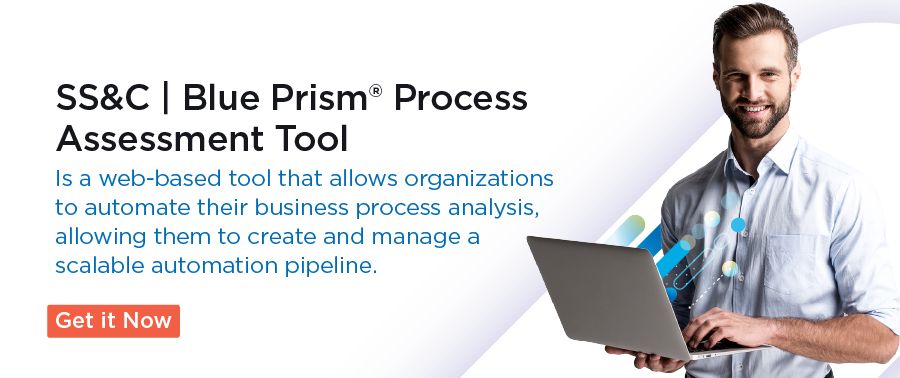Business Process Analysis for Better Automation

Organizations should routinely evaluate their processes to find opportunities for improvements and highlight problem areas. Innovations in technology and evolving competition can put organizational processes out of date or leave them vulnerable to errors. Business process analysis (BPA) offers a strategic approach to business processes.
BPA identifies the places in your core business processes where procedural paths can be optimized. The data gathered from these detailed business process maps will help you create a strategic model for automating your processes.
You might realize it’s time for BPA if you’re noticing bottlenecks in existing “as-is” business processes, delays in fulfilling requests, complaints from customers and employees, or reduced productivity.
Cut out the long, slow analysis of days past. Identify key issues in your organization’s processes with the knowledge of business process analysis.
What is BPA?
BPA is analyzing business operation processes by creating a detailed, step-by-step identification of what works in your processes, where improvements can be made, and how to make them.
The Benefits of Business Process Analysis (BPA)
Conducting a business process analysis or gap analysis on your systems can help align your organization’s overall business goals. Large business organizations produce and store vast amounts of data in their day-to-day operations, and filtering through that information manually can be extremely time-consuming and costly.
BPA reduces waste by turning that data into a cohesive, structured set of insights. This visual model will help you see where you can grow your business and increase your return on investment (ROI). Some advantages of using BPA include:
- Detailed business process mapping
- Thorough documentation of complex processes
- Consistency in delivering quality
- Better alignment with your organization’s overall goal of business processes
- Cutting operational costs
- Business process simplification suggestions
- Detailed evaluation of whether internal processes are working
- Identifying bottlenecks in processes and in users
- Locating the origin of issues or redundancies
- Empowering data-driven business decisions
Why You Should Analyze a Business Process
Many organizations make the mistake of ignoring processes unless there are major, noticeable issues such as high error rates or reduced workflow. But most legacy processes have the potential to be optimized, and a business process analysis will help you determine what and where that potential is so you can achieve a myriad of benefits such as:
- Increased ROI
- Making existing “as-is” business processes more efficient by identifying faster pathways to good results
- Showing what's currently working and where a business process improvement can be made
- Saving money by reducing redundancies, such as eliminating unnecessary or repetitive procedures
- Lowing the risk of human errors
- Monitoring any changes in a process, such as lowered customer engagement, so you can stay on top of anything affecting your overall business value
- Finding where employees are less engaged
- Exposing bottlenecks
- Setting up processes that will help further automation features and scalability
Steps to Performing Business Process Analysis

If your organization wants a better workflow, you can use BPA to structure your data, determine where improvements can be made, and help you manage all the steps of business processes during and after implementation.
Consider this six-step approach when performing a business process analysis:
Identify processes
Start specific. Find your organization’s overall goal, or the process in question most needing investigation and pursue your business objectives from there. Once you have a primary target specified, you’ll be able to keep other involved parties, such as stakeholders, aware of the changes needed. You also need familiarity with the project history so you’re not repeating past efforts.
Define the details
With your goal set, it's time to dig into the details. Identify everything within the organization’s processes, including documentation of existing system supports, and create an inventory list of all applicable data. Define your scope to figure out where to focus your analysis based on your project goals. You’ll want to determine a timeline, specificity, process types, and so on.
Gather and measure data
Unlike step two, the ‘gathering data’ phase of your business process analysis may use process mining and task mining.
Process mining is a set of business process analysis techniques used to understand processes by monitoring key performance indicators (KPIs) and any potential problems within. It examines complete end-to-end processes, including elements running through different IT systems.
Task mining focuses on the smaller components of a process, drilling into the granular details of individual task completion to better understand the steps used in performing any task or business function.
Process mining and task mining are tools to discover end-to-end process flows by tracing transactions using logs and other machine data. They also monitor the desktop to view the work individuals perform to create a visual model of comprehensive data.
In legacy systems, business process analysis requires time-consuming and expensive reporting. But with process mining and task mining, this information gathering uses a single software to locate bottlenecks quickly and accurately.
Analyze your assessment
Prepare your teams to examine the information you’ve gathered from your business process analytics. This could be your IT teams, business analysts, or process architects, or you may have a Center of Excellence (CoE). A CoE is a team of people dedicated to finding the best results for your automation while ensuring compliance and risk mitigation. Business analysts will extract your prepared data to create event logs and optimize them for process mining and analysis staging. All of this is crucial to your BPA.
Highlight and optimize
With all the data you’ve gathered, you can now start identifying those areas with opportunities for improvement. You must focus on places with the highest value return for your organization. While you work through these inefficiencies, remember to always check back with your goal to ensure your current processes are aligned.
Monitor your automation
After the implementation of RPA or IA, it’s essential to have a reliable system in place to manage and optimize your business processes. Your teams will help ensure your BPA is aligned with your organization’s overall goals.
There are a lot of great tools you can use for a business process analysis. Just remember, achieving your goals starts with a strategy. Without a strategy, your organization’s journey can quickly become convoluted and its purpose lost. But with the right tools to help you get a strong start, your BPA can get your organization its target ROI.
SS&C Blue Prism Process Intelligence (BPPI)
BPPI combines process mining and task mining to help you analyze your processes. These insights include optimal process paths, process variation root cause analysis, and best outcome predictive simulations.
From there, the automation chooses the highest ROI process path, optimizing as it goes. It manages and modifies processes to their best potential, working across the enterprise in real time.
SS&C | Blue Prism® Process Intelligence (BPPI) combines process mining and task mining to help you analyze your processes.
SS&C | Blue Prism® Process Assessment Tool
Organizations need an overview of their automation-candidate pipeline, plus a full analysis or visual model of their business processes before starting their automation journey. This is where a process assessment tool can help.
Manual discovery and assessment are costly, time-consuming, and prone to human errors. It can also present risks of poor visibility, bottlenecks, and non-compliance. The SS&C Blue Prism Process Assessment Tool helps eliminate these holdbacks and extracts the data for a more scalable automation pipeline.
SS&C | Blue Prism® Process Assessment Tool is a web-based tool that allows organizations to automate their business process analysis, allowing them to create and manage a scalable automation pipeline.
Our process assessment tool works in three steps:
- Process assessment. Complete a brief online survey and receive instant recommendations for improvement at the end.
- Your processes. After you’ve assessed some of your current processes, the dashboard will show you how many of those processes are ready for automation, how many need review and how many need work before they’re candidates for automation.
- Your spaces. This is a flexible and secure user-group management platform so you can safely roll out and support the process assessment across your enterprise.
A process assessment tool can help you determine the best way to utilize and optimize processes with a wide range of benefits, including:
- Accurate IA. It helps you discover which processes will be easiest to implement so you can optimize your IA.
- Cost savings. It gets your digital workforce on track, securing quick wins and repeatable successes.
- Strategic analysis steps. It initiates data-informed goals.
- Scalable automation. It helps you build a scalable automation pipeline based on the best value and compliance in your processes.
Common terms related to business process analysis
You’ll often hear certain terms when looking at business process analysis. It’s helpful to understand what they mean and how they relate to your BPA:
- Gap analysis is a survey of your organization that finds and fills gaps in your processes.
- Business process management (BPM) covers how we monitor and optimize business processes for the best business outcomes. As an IA technology, it connects end-to-end processes, creating a linkage between business processes and overall business goals to ensure more efficient workflows.
- A process pattern search uses drag-and-drop capabilities to easily build queries and find processes matching those conditions.
- Value-added analysis detects problems in your processes by identifying key components and where cuts can be made.
- Root cause analysis (RCA) detects the origin of issues in processes.
- A detailed case analysis identifies unexpected problems and the causes driving those process behaviors.
- Observational analysis reviews current processes as they’re running to uncover any relevant areas of concern.
- Experience examination analysis identifies significant process areas with the help of experienced staff or business analysts.
- Workflow or journey mapping analyzes queue-based routing like customer service.
Business Process Analysis Examples
Business process analysis will vary depending on your industry. In an HR setting, BPA can be used when onboarding new employees to rework processes so they’re more consistent and efficient.
In retail, BPA can track order fulfillment to view order statuses and prepare for potential shipment delays. Even appointment scheduling and other customer-facing tasks can be improved under the scrutiny of BPA.
What's Next
Once you’ve analyzed your business processes, it’s time to optimize them. While BPA gives new visibility to your business processes, you should still be selective on where to target your automations most effectively. Process mining accelerates automations, but it doesn’t cure all errors. Ensure you have a stable foundation for your business process automation. If you automate a bad process, it doesn't change that problem area.
Once processes are streamlined, you're ready to automate your workflow. Start small and build scalable, efficient solutions. Then monitor your process performance to ensure operations are running smoothly and you’re taking full advantage of the automation capabilities while still meeting your business objectives.
Strategize and optimize to gain the full benefits of business process analysis and intelligent automation.


